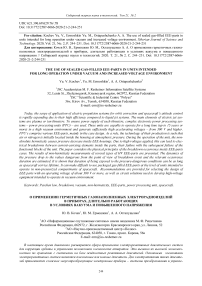The use of sealed gas-filled EEE-parts in units intended for long operation under vacuum and increased voltage environment
Автор: Yu. V. Kochev, Yu. M. Ermoshkin, A. A. Ostapushchenko
Журнал: Siberian Aerospace Journal @vestnik-sibsau-en
Рубрика: Aviation and spacecraft engineering
Статья в выпуске: 2 vol.21, 2020 года.
Бесплатный доступ
Today, the scope of application of electric propulsion systems for orbit correction and spacecraft’s attitude control is rapidly expanding due to their high efficiency compared to liquid jet systems. The main elements of electric jet systems are plasma or ion thrusters. To ensure power supply of such thrusters, complex electronic power processing systems – power processing units (PPU) – are used. These units are capable to operate for a long time (up to 15 years or more) in a high vacuum environment and generate sufficiently high accelerating voltages – from 300 V and higher. PPU’s comprise various EEE-parts, mainly in the case design. As a rule, the technology of their production is such that air or nitrogen is initially located inside the housing at atmospheric pressure. During the operation of the unit, the non-absolute hermeticity causes pressure decrease inside EEE housings. Due to high voltages applied, this can lead to electrical breakdowns between current-carrying ele-ments inside the parts, their failure with the subsequent failure of the functional blocks of the unit. The paper considers the physical principles of the breakdown occurrence inside EEE-parts cases. The results of non-hermiticity measurements of several types of HV EEE-parts are presented. The dynamics of the pressure drop to the values dangerous from the point of view of breakdown event and the relevant occurrence duration are esti-mated. It is shown that duration of being exposed to the pressure-dangerous conditions can be as long as space-craft service lifetime. It can make difficult to use packaged gas-filled EEE-parts at the level of units intended to operate in non-pressurized compartments of spacecraft. Recommendations are provided for selecting the design of EEE parts with an operating voltage of about 300 V or more, as well as circuit solutions used to develop high-voltage equipment intended to operate in vacuum environment.
Paschen law, breakdown, vacuum, non-hermeticity, EEE-parts, power processing unit, spacecraft.
Короткий адрес: https://sciup.org/148321743
IDR: 148321743 | УДК: 621.396.69:629.76/.78 | DOI: 10.31772/2587-6066-2020-21-2-244-251
Текст научной статьи The use of sealed gas-filled EEE-parts in units intended for long operation under vacuum and increased voltage environment
Introduction. As a part of the propulsion subsystems of modern spacecrafts (SC), electric propulsion engines (EPE) are increasingly used [1]. This is primarily due to their better efficiency compared to engines running on chemical fuel. Various types of engines and devices for controlling and powering such engines are being developed all over the world. [2–5]. Further improvement in the characteristics of electric propulsion engines is directly related to the increase in the accelerating voltage generated by the power processing unit (PPU). If the voltage of a widely used domestic engine of the SPT-100 type is about 300 V [6], then in more economical models it is already about 800 V and higher [7; 8]. In this regard, the need to use high-voltage element base in PPU devices is obvious. The reliability of electrical components and their correct application determines the final reliability of the onboard equipment, subsystem, and spacecraft itself. Therefore, the issues of reliability and conditions of use of EEE-parts are very important and relevant.
It should be pointed that current Russian spacecrafts are non-hermetic and designed for 15 or more years of active existence [9]. This means that the EEE-parts used in the spacecraft equipment, including high-voltage ones, must also ensure normal operation in vacuum conditions during this period.
Usually, the design of high-voltage EEE assumes the presence of a sealed housing, inside of which the active element is located (fig. 1).
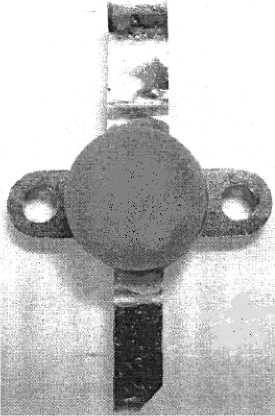
а
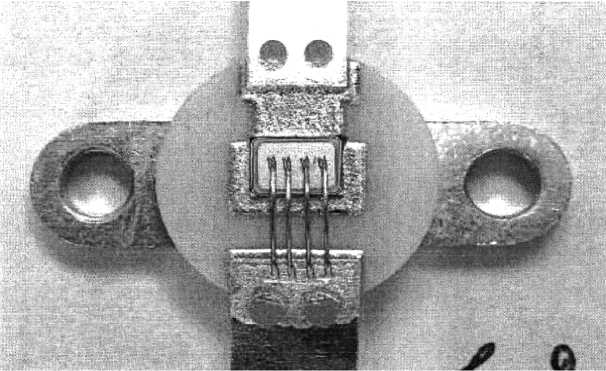
б
Fig.1. Standard hermetic EEE housing design: а – external view; b – view with the case cover removed
Рис. 1. Конструкция корпуса типового герметичного ЭРИ: а – внешний вид; б – вид со снятой крышкой корпуса
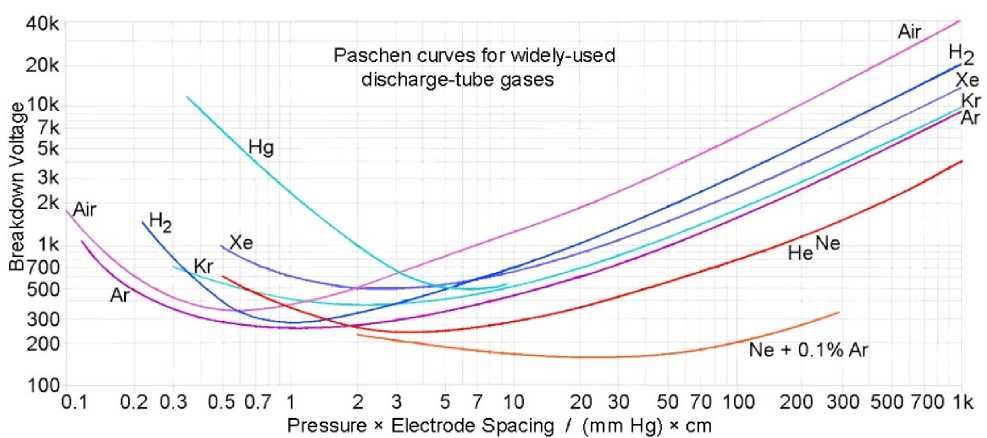
Fig. 2. Paschen curves for different gases
Рис. 2. Кривые Пашена для различных газов
The case is designed to protect active elements during storage and ground operation from mechanical damage and from ingress of foreign pollutants or chemically aggressive substances, primarily moisture, which can cause corrosion. As a rule, air or nitrogen at atmospheric pressure is located inside the case of a manufactured hermetic EEE. However, it is obvious that the tightness of the EEE case can not be absolute. During the operation of the EEE in a vacuum, due to leaks at the place where the cover is attached to the base of the housing and diffusion directly through the housing material, the pressure inside the EEE case inevitably decreases. In accordance with Paschen law, in the presence of high voltage between the inner electrodes of EEE and at the value of inner pressure falls within a certain range (hereinafter “Paschen zone”), you may experience breakdown, leading to electronics failure. It is obvious that the consequence of the EEE failure, depending on the adopted circuit solutions of the device, may be a decrease in its performance up to a complete failure. Note that the level of hermeticity of EEE housings is regulated in the technical specifications (TU) for them and confirmed in the process of qualification and periodic tests of electrical products. It can be 5·10–5 – 5·10–4 cm3·mmHg/s in order of value. Confirmation of the hermeticity parameter during the acceptance tests of the EEE is usually not carried out. It is also obvious that the actual hermeticity of a particular type of EEE may vary, as it depends on many technological factors: the actual size of the case and base of the EEE, the quality of the cover connection, the amount of glue applied, external conditions during the sealing process, etc.
Taking into account the importance of ensuring the normal operation of EEE as a part of high-voltage devices designed to operate in a vacuum it seems appropriate to consider the problem in more detail and outline possible ways to solve it. This article is devoted to the analysis of the causes and conditions of breakdowns in the cases of hermetic EEE, the forecast of the time when the EEE pro- ceeds to the “Paschen zone” and the time spent in it, and the consideration of possible ways to resist this phenomenon to improve the reliability of high-voltage onboard devices of non-hermetic SC.
Physical principles of occurrence of electric discharges within the design of EEE-parts. The effects of electrical breakdowns in high-voltage onboard equipment are well known and studied. In particular, the fact that plasma formed by the spacecraft engines that penetrates into the internal cavities of high-voltage equipment can create conditions for the occurrence of arc discharges [10]. There are recommendations for reducing the probability of electric discharges, for example, minimizing pointed and curved surfaces of conductors and electrodes that lead to strong electric field inhomogeneities [11]. However, these recommendations apply to the device design, EEE and conductors installation. The issues of electrical breakdowns at the level of the EEE structure are currently insufficiently studied.
According to generally accepted concepts, an independent electric discharge in gas occurs because of an electrical breakdown when an ignition voltage is applied between the electrodes. In the case of a homogenous field, the ignition potential depends on the type of gas and on the multiplying the gas pressure P by the distance between the electrodes d. The Paschen law established experimentally says that the lowest ignition voltage of a gas discharge (breakdown voltage) between two flat electrodes is a constant value for the same values of the multiplication P ·d (fig. 2) [12].
The theory of the occurrence of a breakdown (electronic avalanche) in gas was proposed by Townsend [13]. According to this theory the breakdown voltage depends as follows on multiplying the pressure by the electrode spacing:
U пр
B ■ P ■ d
A ■ P ■ d , ln[ ] ln(1 + y- 1)
where γ is the coefficient that characterizes surface ionization (the number of electrons knocked out of the cathode by a single incident ion), B = A φ i , A = ( Р λ)–1, P is the pressure, λ is the free path of electrons under these conditions, and φ i is the ionization potential of the gas molecule (volts).
The diagrams and formulae demonstrate that at a fixed distance between the electrodes there is a pressure range (“Paschen zone”), where the conditions for the breakdown of the interelectrode gap can be created within a certain electric field. It also follows that the greater the applied voltage, the wider “Paschen zone”.
On the right side of the Paschen curve, that is, when the pressure increases, the breakdown voltage increases due to a decrease in the free path of the electrons and a corresponding decrease in the kinetic energy they gain when moving in an external electric field. On the left side of the curve, that is, when the pressure decreases, the breakdown voltage also increases, but due to the decrease in the number of newly appeared electrons because of the frequency collisions fall due to the decrease in the concentration of gas molecules.
The graphs (fig. 2) show that the minimum breakdown voltage for air is 325–330 V at the parameter value P·d ≈ 0.5–0.6 mm Hg·cm. It is obvious that for a particular EEE the constant values are the distance between the electrodes and the maximum applied voltage, and the variable value is the air pressure inside the case. It is also clear that the time of reaching the Paschen zone from the moment of placing the element in a vacuum and the duration of its stay in it depends on the volume of the inside space of the EEE case and the value of the hermeticity index.
The volume of inner space of some typical EEE, as shown below (tab. 1), is in a limited range, about 120–1500 mm3. Therefore, the actual value of the hermeticity index is the decisive factor determining the time of reaching the Paschen zone and the duration of staying in it.
Dynamics of pressure changes inside the EEE case. When considering the change in pressure inside the EEE case, we can use an analogy with the problem of changing the pressure in a vessel when air flows out of it into a vacuum through a small hole. In vacuum technology, this task is interpreted as pumping air out of a vessel using a so-called ideal vacuum pump, which is taken as an environment with zero pressure. The following basic concepts are applied in the theory of vacuum technology [14–16]:
By definition, Q = d ( PV )/ dt – gas flow (leak, flow rate, or leak indicator) – the amount of gas pumped out of the vessel per unit of time. This parameter has a dimension of PA·м3/sec (W) or l·mm Hg/s – for microtubules. It can be measured and depends on the pressure in the vessel.
S – speed (velocity) of pumping out of the vacuum pump or conductivity of the conditional opening – the volume of gas pumped out by the pump per unit of time. Dimension – m3/sec, l/sec. The pumping speed characterizes the pump performance and is determined at a specific pressure, so it is a fixed value.
The following relation connects the parameters Q and S :
Q = S ⋅ P , (2)
where P is the current pressure in the vessel.
Hence, for known initial values P 0 and Q 0:
S = Q 0 . (3)
Based on the definition of the flow, taking into account the constant value of the volume of the inner case space V and the negative value of the pressure change rate (the pressure inside the case of the EEE falls due to micro-leakage), we can write:
Q = S ⋅ P = Q 0 ⋅ P =- V ⋅ dP
P 0 dt
or
Q 0 ⋅ dt =
V ⋅ P 0
-
dP P
.
After integrating (5) from 0 to t and from Р 0 to P , we get the time of pressure reduction inside the case from P 0 to P :
t=
V ⋅ P 0 ⋅ ln( P 0).
Q 0 P
Accordingly, the value of the pressure inside the case in time t after placing the EEE in a vacuum is:
- Q 0 ⋅ t
P = P 0 ⋅ e P 0 ⋅ V . (7)
It should be noted that the standard conditions for determining leaks are pressure difference between the inner and outer sides of the product Δ P = 105 PA (1 atm ), test gas – air, temperature –298 K. The flow of a leak in standard conditions is indicated by the symbol B . However, in practice, the leak value is determined not by air, but by the test gas, (in most cases – helium). For the molecular flow regime, the ratio between the flow in standard B and test Q conditions is valid [16]:
B=Q0 ⋅

\ MВ
where M Г ≈ 4 – is the molecular weight of the sample gas (helium), M В ≈ 29 – is the molecular weight of the air.
Since in this example we consider the outflow of air from the EEE case, and the flow Q is determined experimentally by helium, in formulas (6), (7), the parameter Q 0 should be multiplied by the value ( М Г /М В) – 1/2 = 0.375. Then the formula (6) is refined:
t = 2,67 ⋅ V ⋅ P 0 ⋅ ln( P 0). (9) , Q 0 P
If t 1 is the time of pressure reduction from the initial Р 0 to the upper border of the Paschen zone Р 1 , and t 2 is the time of reduction to the lower border Р 2 , then the interval of time spent in the Paschen zone:
∆ t = t 2 - t 1 = 2,67 ⋅ V ⋅ P 0 ⋅ ln( P 1). (10)
Q 0 P 2
To estimate the time of pressure reduction from atmospheric to the upper and lower limits of the dangerous range, it is necessary to know the level of actual non-hermeticity of the EEE case, that is, the value of the leak Q 0 . The main factor affecting this indicator is the design of the element and the method of sealing the housing. Depending on the design and manufacturing method, elements can be distinguished: a) with ceramic housings, the hermeticity of which is provided by an adhesive connection; b) with metal-glass housings, the hermeticity of which is provided by welding; c) metal-ceramic housings, the hermeticity of which is provided by seam-roller welding. At JSC “SPC “Polyus”, samples of some high-voltage EEE manufactured using various technologies were tested. They showed that the actual value of the hermeticity index is 1–2 orders less than in the technical specifications (TS) per element, that is, the actual leak is significantly less than indicated in the TS. The test results for various types of EEE are shown in tab. 1.
Using the formula (10), we estimate the time required for the pressure in the inside the housing to decrease from the initial value of 1 atm to the Paschen zone, as well as the time spent in this zone (fig. 3), based on the norm of the hermeticity index for the TS and the measured values (see tab. 1). Since the actual value of the leak has a spread, the maximum possible duration of stay in the danger zone for this type of EEE is equal to the difference between the time of exit from the zone at the minimum leak and the time of entry at the maximum leak.
The calculated data on pressure drop times for various levels of hermeticity index, operating voltages and types of EEE, shown in tab. 1, are presented in tab. 2. The considered types of EEE do not have protection of the electrodes with an insulating compound, with the exception of type 2.
Analysis of the results obtained. From tab. 1, 2 and fig. 3, we can conclude the following:
-
1. The actual level of the hermeticity index is usually 1–2 orders lower than the level recorded in the TS per element.
-
2. The actual level of the hermeticity index depends on the design of the EEE and has the highest values (maximum leak) for EEE with ceramic housings, the hermeticity of which is provided by an adhesive connection.
-
3. There is a significant variation in the actual values of the hermeticity index of a particular type of EEE (up to 40 times), due to various technological factors.
-
4. The time to reach the upper border of the Paschen zone from the start of operation in full-scale conditions, as well as the duration of stay in this zone depends on the actual level of the EEE hermeticity index, the value of the subcase volume and the maximum operating voltage between the internal electrodes. The duration of being in a dangerous zone can range from two weeks to several tens or even hundreds of years.
These conclusions, at least, call into question the possibility of normal operation of gas-filled high-voltage housing EEE in vacuum, since during the long-term operation of the product (15 years or more), elements of this type must necessarily fall into the Paschen zone with an increased risk of breakdown.
In addition, the analysis of existing domestic standards regulating the methodology of qualification and acceptance tests of EEE was carried out. It showed that tests of high-voltage EEE for the occurrence of electrical breakdowns in the sub-housing space are not currently provided.
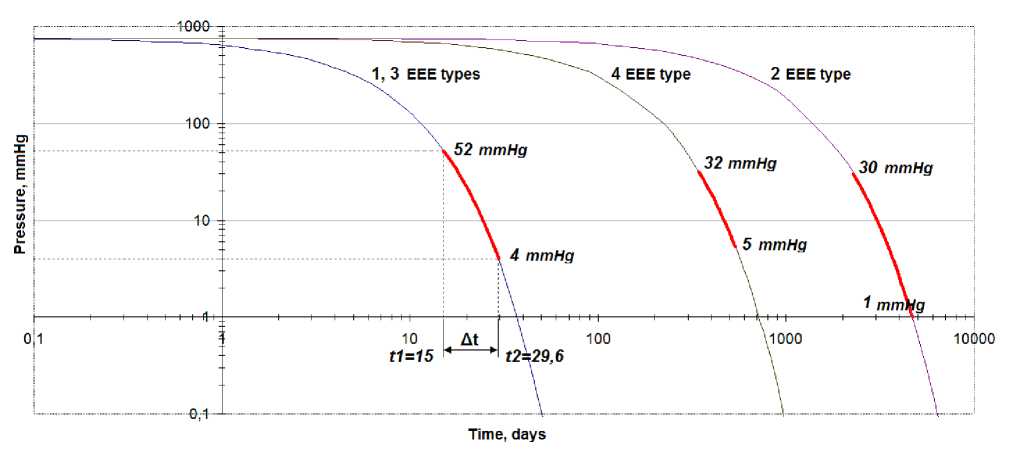
Fig. 3. Graph of pressure drop at the rate of hermeticity index for TS with indication of the Paschen zone for each type of EEE (pressure, mmHg; types of EEE; time, full day)
Рис. 3. График спада давления при норме показателя герметичности по ТУ с указанием зоны Пашена для каждого типа ЭРИ (давление, мм рт.ст.; типы ЭРИ; время, сут.)
Table 1
Design, parameters, regulated and actual levels of the EEE hermeticiry index of various types
|
Type |
Design |
Operational voltage (TS) |
Inner volume |
Min distance between electrodes |
Hermeticity index Q 0 (TS), |
Q 0 (measured valume) |
Quantity |
|
V |
mm |
mm |
cm3·mmHg·s-1 |
cm3·mmHg·s-1 |
item |
||
|
1 |
Ceramic housings, hermeticity provided by an adhesive connection |
600 |
120 |
0.5 |
5·10-4 |
7.6·10-6 – 9.8·10-5 |
97 |
|
2 |
Metal-glass housings, hermeticity provided by welding |
800 |
1500 |
1.5 |
5·10-5 |
1.9·10-6 – 7.5·10-5 |
15 |
|
3 |
Metal-ceramic housings, hermeticity provided by seamroller welding |
600 |
120 |
0.5 |
5·10-4 |
2.6·10-6 – 9.5·10-6 |
15 |
|
4 |
Metal-ceramic housings, hermeticity provided by seamroller welding |
450 |
230 |
0.5 |
5·10-5 |
2·10-6 – 5.5·10-6 |
15 |
Table 2
Time of pressure decline to the Paschen zone, duration of stay in it for the EEE of different types and different hermeticity indexes
|
Type of EEE |
Paschen zone, mmHg |
Hermeticity index, cm3·mmHg·s-1 |
Time of decline to the upper border of the Paschen zone, days |
Time of decline to the lower border of the Paschen zone, days |
The duration of stay in the Paschen zone, days |
|
1 |
4–52 |
TS |
15 |
29 |
14 |
|
act., max |
77 |
– |
1869 |
||
|
act., min |
– |
1946 |
|||
|
2 |
1–30 |
TS |
2277 |
4674 |
2397 |
|
act., max |
1518 |
– |
121475 |
||
|
act., min |
– |
122993 |
|||
|
3 |
4–52 |
TS |
15 |
29 |
14 |
|
act., max |
796 |
– |
4892 |
||
|
act., min |
– |
5688 |
|||
|
4 |
5–32 |
TS |
342 |
543 |
201 |
|
act., max |
3111 |
– |
10458 |
||
|
act., min |
– |
13569 |
From the above, we concluded that the use of high-voltage gas-filled EEE as part of devices that operate for a long time in vacuum without additional measures that reduce the probability of breakdown is associated with high risk.
Possible ways to solve the problem of ensuring long-term operation of high-voltage devices in vacuum conditions. We can offer developers of high-voltage devices with a long service life, designed to work in a vacuum the following logic for designing devices using high voltage EEE:
-
1. If possible, build the device circuitry in such a way that the maximum voltage between the internal EEE electrodes does not exceed the breakdown voltage according to Paschen law (with some extra), for example, not more than 250 V.
-
2. If it is impossible to avoid operating modes of high-voltage EEE with a voltage of about 300 V or higher, then you should use a special version of EEE, which would exclude the possibility of a breakdown according to the Paschen law. In particular, JSC “SPC “Polyus” considered the following options for modification of EEE hous-
- ing: a) coating the internal electrodes and the crystal with insulating compounds; b) partial filling of the inner cavity with an insulating compound; c) total filling of the inner cavity with an insulating compound.
-
3. Replacing the “small leak” with the “large leak” by performing special holes in the EEE housing to remove the internal atmosphere of the EEE during the initial period of operation of the device in vacuum. Switching on the device should be carried out after guaranteed removal of air from the sub-housing space of the EEE, that is, when the pressure decreases below the lower border of the Paschen zone.
Experimental studies have shown that the best solution in terms of ensuring the resistance of the EEE to electrical breakdowns is option b), that is, a continuous filling of the inner space with an insulating compound. Other methods enhanced the resistance of the sub-housing space to electrical breakdowns, but did not completely exclude them.
Conclusion. An analysis of the operating conditions of hermetic EEE with gas-filled housing as part of longterm vacuum-operated devices of non-hermetic design shows that EEE of this type due to natural leaks can fall into a dangerous zone from the point of view of electrical breakdown by internal pressure. At the same time, the time of getting into this zone and, more importantly, the duration of being in it have a significant spread – from two weeks to several decades, that is, the element can be in the danger zone for almost the entire life of the SC. This circumstance bring into question the possibility of using EEE of this type in accordance with the technical specifications as a part of long-life devices of non-hermetic design without special measures to exclude the possibility of breakdowns due to the Paschen effect. These measures include reducing the operating and maximum voltage between the EEE electrodes to the level below the breakdown level, carried out by special circuit solutions, modifying the EEE by filling the inside housing space with an insulating compound, or using specially designed EEE for working in vacuum (ventilated or in a non-housing version).
Список литературы The use of sealed gas-filled EEE-parts in units intended for long operation under vacuum and increased voltage environment
- Lev D., Myers R. V., Lemmer K. M. et al. [The Technological and Commercial Expansion of Electric Propulsion in the Past 24 Years]. 35th Electric Propulsion Conference. IEPC-2017-242. Georgia Institute of Technology. USA, October 8–12, 2017, 18 p.
- Boniface C., Castanet F., Giesen G. et al. [An overview of French electric propulsion activities at CNES]. 36th International Electric Propulsion Conference. IEPC-2019-253. University of Vienna, Vienna, Austria, Sept. 15–20, 2019, 22 p.
- Lev D., Zimmerman R., Shoor B. et al. [Electric Propulsion Activities at Rafael in 2019]. 36th International Electric Propulsion Conference. IEPC-2019-600. University of Vienna, Vienna, Austria, Sept. 15–20, 2019, 9 p.
- Bourguignon E., Fraselle S. [Power Processing Unit Activities at Thales Alenia Space in Belgium]. 36th International Electric Propulsion Conference. IEPC-2019-584. University of Vienna, Vienna, Austria, Sept. 15–20, 2019, 8 p.
- A. Mallman, F. Forrisi, E. Mache et al. [High Voltage Power Supply for Gridden Ion Thruster]. 36th International Electric Propulsion Conference. IEPC-2019-A512. University of Vienna, Vienna, Austria, Sept. 15–20, 2019, 7 p.
- Mitrofanova O. A., Gnzdor R. Yu., Murashko V. M., Koryakin A. I., Ntsterenko A. N.. [New Generation of SPT-100]. 32nd Inernational Electric Propulsion Conference, IEPEC-2011-041, Wiesbaden, Germany, Sept. 11–15, 2011, 7 p.
- Kostin A. N., Lovtsov A. S., Vasin A. I., Vorontsov V. V. [Development and qualification of Hall thruster KM-60 and the flow control unit]. 33st International Electric Propulsion Conference, IEPC-2013-055, the George Washingtin University, USA, Okt. 6–10, 2013, 11 p.
- Lovtsov A. S., Tomilin D. A., Muravlev V. A. [High-voltage Hall’s thrusters development in Keldysh Centre]. 68th Astronautical Congress, Adelaide, Australia, IAC-17-C4.4.4, 25–29 September 2017, 5 p.
- Kosmicheskie vekhi: sb. nauch. tr. [Space landmarks: papers collection]. OАО “Informacionnye sputnikovye sistemy” im. Akad. M. Ph. Reshetneva”. Krasnoyarsk, 2009, 704 p.
- Ivanov V. V., Maksimov I. A., Balashov S. V., Pervukhin A. V., Nadiradze A. B. [The methodology to ensure immunity of the satellite equipment of plasma from the stationary plasma thrusters]. Aviacionnaya i kosmicheskaya tekhnika. VestnicSibGAU. 2006, No. 1, P. 76–80 (In Russ.).
- ESCC-E-HB-20-05A Space engineering. High voltage engineering and design handbook, 2012. 219 p.
- Wittenberg H. H. [Gas Tube Design]. From: Electron Tube Design, RCA Electron Tube Division, 1962. P. 792–817.
- Raizner Yu. P. Phizika gazovogo razryada [Gas discharge physic]. Moscow, Nauka Publ., 1992, 535 p.
- Korolev B. I. Osnovy vakuumnoi tekhniki [Vacuum technique basis]. Moscow, Energiya Publ., 1975, 416 p.
- Vinigradov M. L., Karganov M. V., Kostrin D. K. [The analysis of sensitivity of leak detection methods and a technique for its improvement]. Control. Diagnostika. 2016, No. 5, P. 36–42 (In Russ.).
- Rot A. Vacuumnye uplotneniya [Vacuum Sealing Techniques]. 1971, Moscow, Energiya Publ., 464 p.

